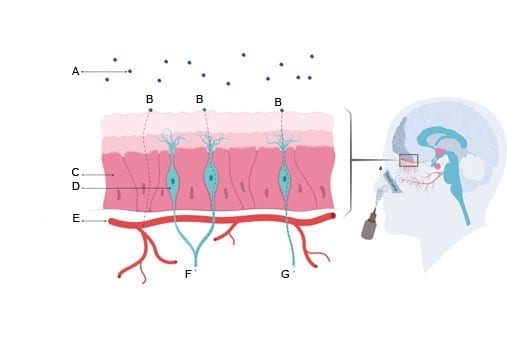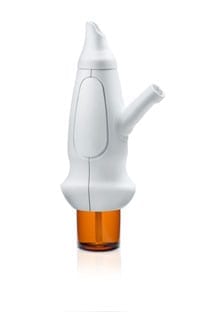
Researchers at UiO have tested a new device for delivering hormone treatments for mental illness through the nose. This method was found to deliver medicine to the brain with few side effects.
About one out of every hundred Norwegians develop schizophrenia or autism in the course of their lifetime. Moreover, at any one time some 20 000 people are receiving treatment for these problems. Many psychiatric disorders such as autism, schizophrenia and bipolar disorder are characterised by poor social functioning.
Oxytocin is a hormone that influences social behaviour and has shown promise for the treatment of mental illness.
Researchers at UiO have now discovered that low doses of oxytocin may help patients with mental illness to better perceive social signals. As part of this project, they have collaborated with the company OptiNose, who have developed a new device designed to improve medicine delivery to the brain via the nose.
Regulates social behaviour
Oxytocin has historically been known to play a crucial role in child rearing as it facilitates pregnancy, birth, and the release of milk during nursing. Further, oxytocin helps regulate cardiac functions and fluid levels. More recent research has revealed the importance of oxytocin for social behaviour.
Oxytocin is a neuropeptide and was discovered in 1953. Peptides are a group of molecules that consist of a chain of amino acids. Amino acids are also known as the building blocks of proteins, which we find in all types of cells. Oxytocin is produced in the hypothalamus, which is the brain’s coordinating centre for the hormone system.

Medicine through the nose
Because of oxytocin’s role in social behaviour, researchers have explored the possibility of administering the hormone for the treatment of mental illness. As oxytocin is a relatively large molecule, it has trouble crossing the barrier between the brain and circulating blood. Thus, researchers have administered oxytocin to patients through the nose as this route offers a direct pathway to the brain that bypasses this barrier.
However, researchers have a poor understanding of how oxytocin reaches and affects the brain. The most effective dose for treatment has also received little research attention.
Professor Ole A. Andreassen and his research team have collaborated with OptiNose on a project that evaluated two different doses of oxytocin and on how they affect the way in which social signals are perceived.
Low doses work best
Sixteen healthy men received two different doses of oxytocin, along with placebo. Volunteers were also given an intravenous dose of oxytocin, for a comparison of the effects of oxytocin in circulating blood. The research showed that only those administered a low dose of oxytocin experienced an effect on how they perceived social signals.
Professor Ole A. Andreassen explains:
“The results show that intranasal administration, i.e. introducing oxytocin through the nose, affects the function of the brain.
As no effect was observed after intravenous treatment, this indicates that intranasally administered oxytocin travels directly to the brain, as we have long believed.
The fact that we have shown the efficacy of a low dose of oxytocin on social perception is even more important.
A dose that is lower, but that still influences behaviour, will entail a lower risk of affecting other regulatory systems in the body. Very high doses of oxytocin could, in fact, have the opposite effect on social behaviour.”
The scientists also discovered that individuals with larger nasal cavities had a stronger response to a low dose of oxytocin.
Breathing helps
OptiNose uses a new technology to distribute medicine to the brain, making use of the user’s breath to propel medicine deep into the nasal cavity.
Read more: Nasal spray device for mental illness
The Latest on: Oxytocin
[google_news title=”” keyword=”Oxytocin” num_posts=”10″ blurb_length=”0″ show_thumb=”left”]
via Google News
The Latest on: Oxytocin
- Here's why our partner's natural scent makes us want to sniff them foreveron April 28, 2024 at 7:52 am
While there are countless things we love about our partners, it’s their natural pheromones and scent (not some deodorant as shown in commercials) that are most attractive. Long story short, your ...
- Spicing things up on National Kiss Your Mate Dayon April 28, 2024 at 6:11 am
Intimate moments are vital in healthy relationships. Body language expert, Blanca Cobb, helps couples spread love in light of the national holiday.
- How Do I Know If My Dog Is Happy? 12 Signs of a Happy Dogon April 27, 2024 at 2:09 pm
Decoding your dog’s happiness Of course, we want our pups to be happy from head to tail, but what does happiness look like in dogs? Dog behavior is complex, so it can be hard to tell how our pups feel ...
- 'Aftercare' Is The BDSM Practice We Should Use For Vanilla Sex, Tooon April 26, 2024 at 7:15 pm
In the world of BDSM, aftercare is a post-play ritual in which partners exchange physical or emotional comfort following an intense sexual experience. And it’s high time we make it a standard part of ...
- Microwave Wear Their Influences Proudly On ‘LSD’on April 26, 2024 at 8:47 am
I’ll call Microwave ’s fourth album by its actual name just once and honor frontman Nathan Hardy’s desire to have everyone else just use the acronym going forward. “We just love drugs,” he deadpans ...
- This 4-Week Challenge Will Deepen Emotional Intimacy in Your Relationshipon April 26, 2024 at 7:54 am
Intimacy is key in a healthy, successful relationship, but sexual intimacy is not the only kind of intimacy that matters. That's right, friends—I'm talking about emotional intimacy, which is all about ...
- 45 vintage photos that will make you laughon April 25, 2024 at 8:51 am
Laughter is a universal language. From stylish dogs to famous people joking around, these vintage photos will make you smile.
- Mapping the Neural Circuit of Social Avoidanceon April 25, 2024 at 7:51 am
Moving forward, Lin plans to continue studying this circuit to uncover other neuronal populations and brain regions that may contribute to social avoidance learning. She also wants to examine this ...
- Ypsilanti elementary schoolers asked for a puppy, and the district said yeson April 25, 2024 at 2:49 am
Brick Elementary School will get its very own therapy dog after the school board unanimously approved the program.
- HC notice to Centre on petition against use of Oxytocin for increasing milk productionon April 23, 2024 at 8:10 pm
The Punjab and Haryana High Court today issued notice of motion to the Union of India, among others, on a petition filed in public interest ...
via Bing News










